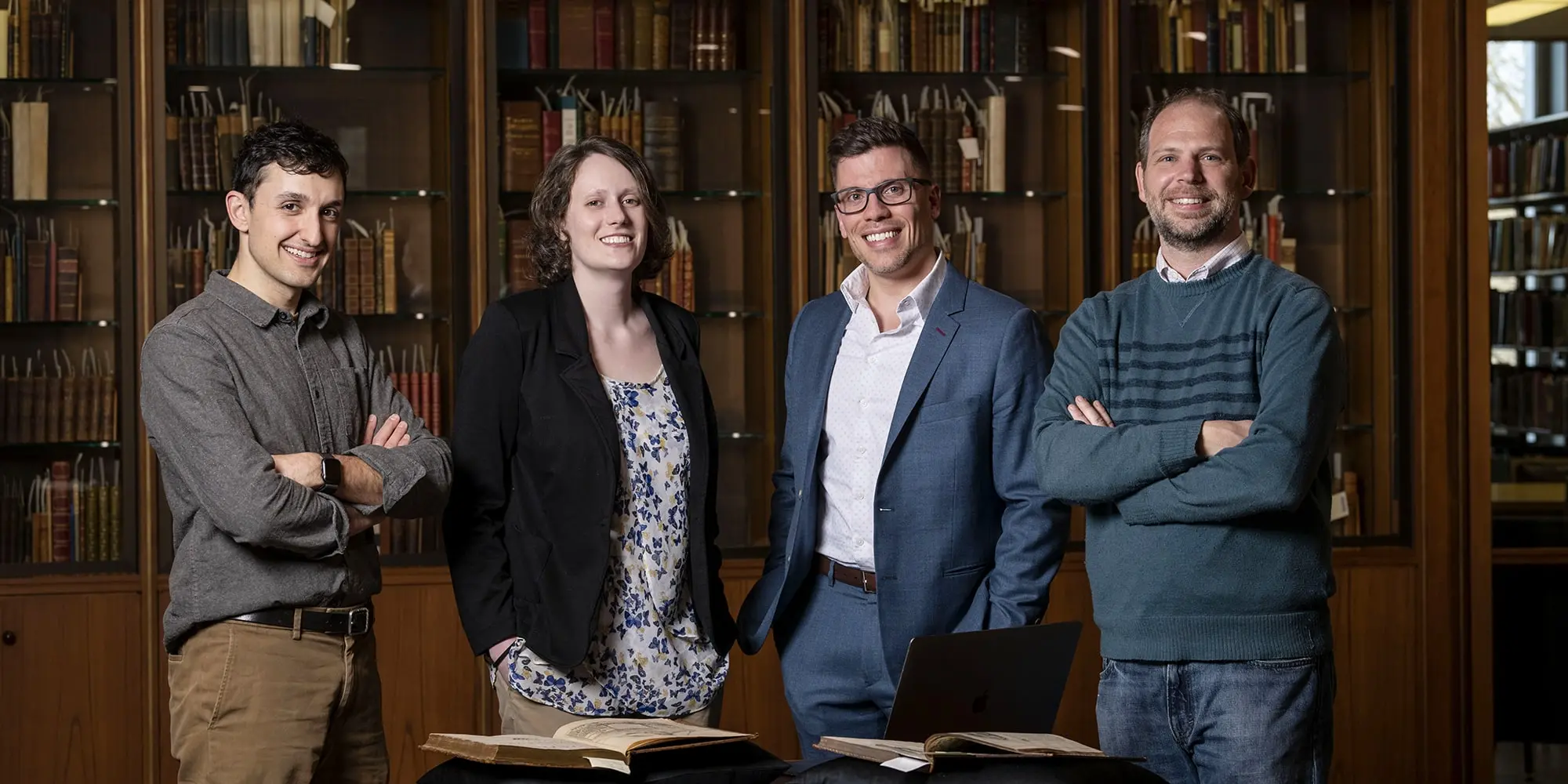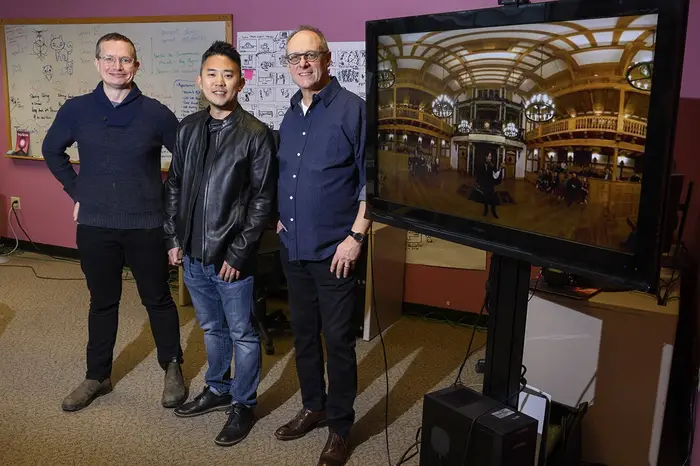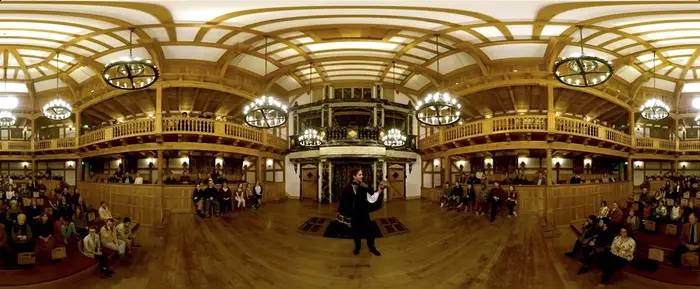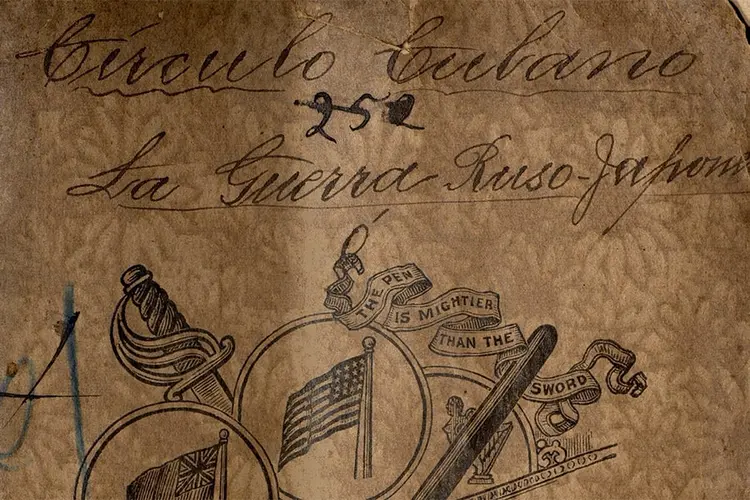
CMU Projects Sleuth Secret Printers, Teach Shakespeare in VR
Media Inquiries
The study of the human experience, which is at the core of a humanities education, is being transformed by the emergence of big data, computational thinking and virtual reality. Two Carnegie Mellon University projects that use technology as a tool for uncovering lessons about our history and culture have received grants from the National Endowment for the Humanities.
Christopher Warren(opens in new window), associate professor of English and history and associate department head of English; Max G'Sell(opens in new window), assistant professor of statistics and data science; Samuel Lemley(opens in new window), curator of special collections at CMU Libraries; and Matthew Lincoln, senior software engineer for text and data mining at JSTOR Labs, received a $324,931 Digital Humanities Advancement grant for their project "Freedom and the Press before Freedom of the Press." In addition, Stephen Wittek(opens in new window), an assistant professor of English, received a $100,000 prototyping grant for Shakespeare-VR.
"These NEH grants will support educators and scholars in enriching our understanding of the past and enable cultural institutions from across the country to expand their offerings, resources, and public programming, both in person and online," said NEH Acting Chair Adam Wolfson(opens in new window).
Freedom and the Press before Freedom of the Press: Tools, Data and Methods for Researching Secret Printing
For fear of persecution and punishment, printers in the 17th and 18th centuries declined to attach their names to controversial books and pamphlets, leaving the origin of many historical texts unidentified. Warren, G'Sell, Lemley and Lincoln aim to produce tools and data that will allow for greater understanding of notable printers in the English-speaking world, specifically around the prehistory of the First Amendment. Knowing what was dangerous about making and circulating these arguments can aid in understanding why the amendment exists.
"Most people these days think of 'the press' metaphorically, but we're interested in the actual, literal presses that were used to print politically sensitive pamphlets, often ones that questioned the legitimacy of monarchy. Printers are printing books that challenge religious orthodoxy. They're printing books and pamphlets that raise uncomfortable questions for particular audiences," Warren said. "If people think they're going to be jailed or worse for what they're printing, they're going to do everything they can to cloak their identity. For example, if you don't want authorities sniffing around your press, one way to throw them off the scent is to make them think that the book was printed in a different city entirely."
Certain characteristics make printers of past documents possible to identify.
"How do you know if something was printed by a particular person? The most persuasive evidence of clandestine printing often lies below the threshold of human attention — in minute typographical details, recurring pieces of damaged type, similar or divergent paper stocks, or tiny variations in print shop practices, observable only at scale," Warren said.
Lemley noted that the labor-intensive work of scouring printed records "requires myopia-inducing focus and entire careers spent traveling to see hundreds of copies of books in libraries around the world. And even then, the judgment of experts remains subjective."
"Our methods, which are really new tools for doing research with rare books, promise to push the field known as analytical bibliography in new and exciting directions. Or remake it, really," Lemley said. "We've started referring to our work as 'computational bibliography' in that we're doing orthodox bibliographical analysis but with the speed and scale afforded by computers."
The grant will support research to help identify distinctive features of 241 late 17th-century printers by Warren and the team, which includes CMU history Ph.D. student Kari Thomas, Simmons University library and information science graduate student D.J. Schuldt, and longtime collaborators Taylor Berg-Kirkpatrick, an assistant professor at University of California, San Diego; Nikolai Vogler, a graduate student at UC San Diego; and Kartik Goyal, a research assistant professor at Toyota Technological Institute at Chicago. The tools the group will be developing as part of the grant include the Digital Library of Distinctive Type and G'Sell's Coloring Book Paper Analysis Tool(opens in new window), which currently exists as a prototype.
According to Warren, the Digital Library of Distinctive Type and the Coloring Book Paper Tool are for researchers who have an interest in the history of clandestine printing and are hoping to find out who printed a certain text.
"An interesting feature of a lot of clandestine books is that maybe something was snuck in at the last minute or printed on a different press; you could have one book that was printed at two different print shops," Warren said. "How would you ever know that? One way is by looking at the paper. The paper's physical characteristics are going to differ according to the print shop and where it was on a stack."
"Freedom and the Press before Freedom of the Press" draws from previous research from Warren and his team. In the past, they received support from an A.W. Mellon digital humanities seed grant, the National Science Foundation and the Pittsburgh Supercomputing Center. In 2019, the group discovered the printers of "Areopagitica,"(opens in new window) one of the most significant documents in the history of the freedom of the press.
The technology Warren and his team are building on with the NEH grant has led to significant discoveries, including the printer of Thomas Hobbes' "Leviathan."
Noel Malcolm, an expert on English philosopher Thomas Hobbes, theorized that one edition of "Leviathan" was printed clandestinely much later than the year on its title page. Knowing CMU Libraries has a copy of one of these versions — the 'Ornaments' Edition — Warren, Lemley, G'Sell, and former English Ph.D. students Avery Wiscomb and Pierce Williams, felt they had the tools to investigate. While testing Malcolm's theory, they uncovered that version of "Leviathan" was printed by John Richardson(opens in new window).
Shakespeare-VR
Shakespeare-VR, which launched in 2019, uses virtual reality technologies to bring students face-to-face with professional actors performing Shakespeare in venues like the Globe and Blackfriars theatres.
"Shakespeare has this enormous footprint in our culture. He's by far the most celebrated author in the Western canon and probably in the history of human letters," Wittek said. "There are statues of Shakespeare in parks around the world. Whether you realize it or not, you probably hear references and quotes from Shakespeare every time you pick up a newspaper or watch television. His works are performed in thousands of iterations every single year."
Through the grant, Wittek and his team will hire real actors and film their performances of "Hamlet," "Macbeth" and "Romeo and Juliet." Those filmed performances will become the basis for a 3D reconstruction, not a 2D image, that users see when they go into virtual reality. The VR technologies are designed by Jaehee Cho, a graduate of the Entertainment Technology Center, and Ralph Vituccio, a teaching professor in the ETC, and aim to approximate the existing feeling of performing.
The Shakespeare-VR group, from left to right: Stephen Wittek, Jaehee Cho and Ralph Vituccio.
"The number one way to understand Shakespeare is to attend a live performance. It is really essential to try to get students outside of the classroom and get the real feel," Wittek said. "VR provides the next best experience. Unfortunately, going to the theater is something that is not doable for a lot of people."
After a 2018 visit to the Blackfriars Theater in Staunton, Virginia, Vituccio saw the potential of placing a user in a Shakespeare play and giving them the ability to interact with other characters. Through Shakespeare-VR and his own VR productions, Vituccio has witnessed what VR can add to the learning experience.
"I believe certain serious immersive VR interactions can be used to induce empathetic reactions aimed at social change. It's somewhat like allowing users to 'walk in someone else's shoes' and experience life through another's eyes," Vituccio said. "By allowing users to play a part in a Shakespeare play, interacting, and talking with other characters, I believe will be a transformational experience. By fostering a deeper understanding of the power, depth and longevity of Shakespeare's phrases and sonnets, the interactive Shakespeare will be a game changer in theater academics, training actors, entertainment, and bringing the Bard's influence to light for many more to appreciate."
While there are other adaptations of bringing Shakespeare into virtual reality, Wittek's Shakespeare-VR is free to use and aimed toward education and providing a historical perspective and context. With a VR headset on, students are able to watch Shakespearean scenes or act out parts themselves, having full control of the stage.
A panoramic image from Shakespeare-VR, from the user's perspective.�
"I hope Shakespeare-VR will help to introduce students to theatrical history, that it will help to enforce a sense that this literature isn't just poetry, that it is drama and comes alive in the theater. Although Shakespeare is also aware of his reading audience, I think the primary audience that he has in mind will be the theatrical audience," Wittek said. "In a way, just reading the script of a play is kind of like reading a recipe without ever getting to taste the cake. I think a project like Shakespeare-VR helps give students a sense of what the cake actually tastes like."
Sarah Enloe(opens in new window), director of education at the American Shakespeare Center, said virtual reality like Shakespeare-VR will change the way students learn about the writer and his works.
"I cannot proclaim loudly enough how wonderful virtual reality can be for pedagogical practice," Enloe said. "Your students will experience Shakespeare in a community, as Shakespeare imagined it be, and they will see that there is opportunity for an actor to direct something to an audience member. That's very difficult to describe in a classroom, but when you see it happen on screen, you finally understand that all those question marks and all of those long speeches and everything that your students are wrestling with is there for a reason. It's there because the audience is part of the play."


